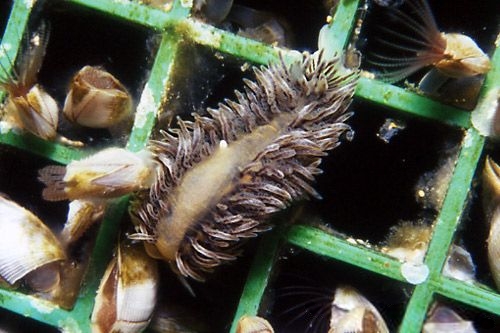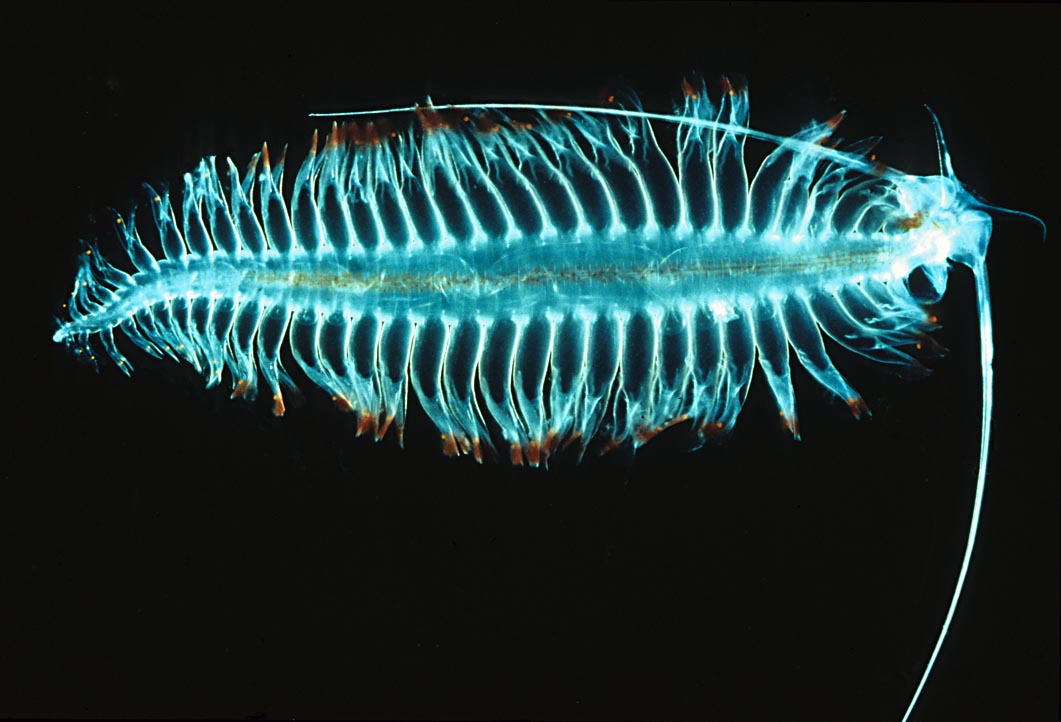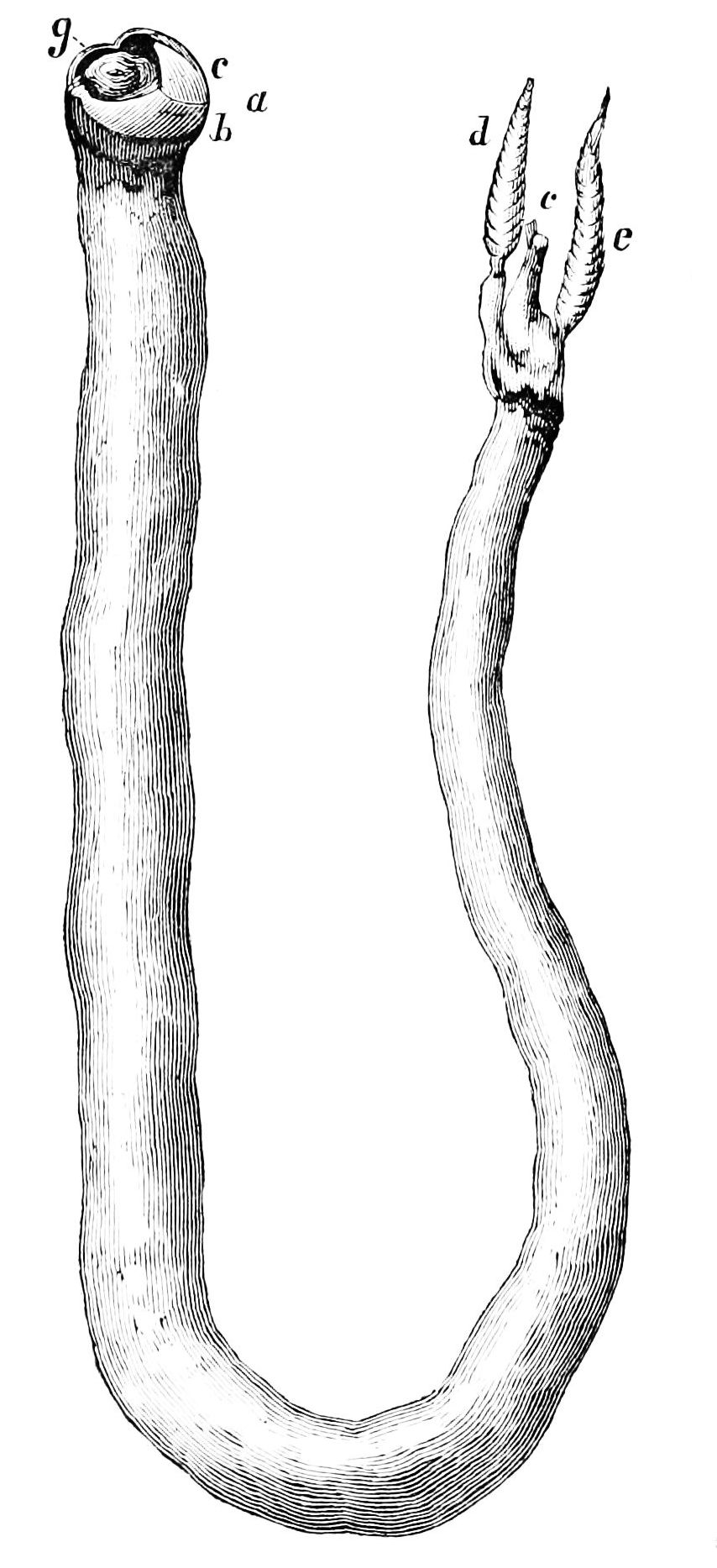|
Veliger
A veliger is the planktonic larva of many kinds of sea snails and freshwater snails, as well as most bivalve molluscs (clams) and tusk shells. Description The veliger is the characteristic larva of the gastropod, bivalve and scaphopod taxonomic classes. It is produced following either the embryonic or trochophore larval stage of development. In bivalves the veliger is sometimes referred to as a D-stage (early in its development) or pediveliger (late in its development) larva. This stage in the life history of these groups is a free-living planktonic organism; this mode of life potentially enhances dispersal to new regions far removed from the adult mollusks that produced the larvae. The general structure of the veliger includes a shell that surrounds the visceral organs of the larva (e.g., digestive tract, much of the nervous system, excretory organs) and a ciliated velum that extends beyond the shell as a single or multi-lobed structure used for swimming and particula ... [...More Info...] [...Related Items...] OR: [Wikipedia] [Google] [Baidu] |
Fiona Pinnata
''Fiona pinnata'', common name Fiona, is a species of small pelagic nudibranch (sea slug), a marine gastropod mollusk in the superfamily Fionoidea. This nudibranch species lives worldwide on floating objects on seas, and feeds mainly on barnacles, specifically goose barnacles in the genus ''Lepas''. The anatomy of this species is very unusual. It is currently the only named member of the genus ''Fiona'' but a 2016 study showed that this species is a species complex. The family Fionidae was expanded in 2016 to include Tergipedidae, Eubranchidae and Calmidae as a result of a molecular phylogenetics study. Features that are characteristic of the genus ''Fiona'' includeWillan R. C. (1979) "New Zealand locality records for the aeolid nudibranch ''Fiona pinnata'' (Eschscholtz)". ''Tane'' 25: PDF/ref> the similar-looking oral tentacles and rhinophores; the cerata with a membrane and lacking a cnidosac; a dorsal anal opening; a reproductive system with two genital openings; two jaws with ... [...More Info...] [...Related Items...] OR: [Wikipedia] [Google] [Baidu] |
Plankton
Plankton are the diverse collection of organisms found in Hydrosphere, water (or atmosphere, air) that are unable to propel themselves against a Ocean current, current (or wind). The individual organisms constituting plankton are called plankters. In the ocean, they provide a crucial source of food to many small and large aquatic organisms, such as bivalves, fish and whales. Marine plankton include bacteria, archaea, algae, protozoa and drifting or floating animals that inhabit the saltwater of oceans and the brackish waters of estuaries. Freshwater plankton are similar to marine plankton, but are found in the freshwaters of lakes and rivers. Plankton are usually thought of as inhabiting water, but there are also airborne versions, the aeroplankton, that live part of their lives drifting in the atmosphere. These include plant spores, pollen and wind-scattered seeds, as well as microorganisms swept into the air from terrestrial dust storms and oceanic plankton swept into the air ... [...More Info...] [...Related Items...] OR: [Wikipedia] [Google] [Baidu] |
Cilia
The cilium, plural cilia (), is a membrane-bound organelle found on most types of eukaryotic cell, and certain microorganisms known as ciliates. Cilia are absent in bacteria and archaea. The cilium has the shape of a slender threadlike projection that extends from the surface of the much larger cell body. Eukaryotic flagella found on sperm cells and many protozoans have a similar structure to motile cilia that enables swimming through liquids; they are longer than cilia and have a different undulating motion. There are two major classes of cilia: ''motile'' and ''non-motile'' cilia, each with a subtype, giving four types in all. A cell will typically have one primary cilium or many motile cilia. The structure of the cilium core called the axoneme determines the cilium class. Most motile cilia have a central pair of single microtubules surrounded by nine pairs of double microtubules called a 9+2 axoneme. Most non-motile cilia have a 9+0 axoneme that lacks the central pair of mi ... [...More Info...] [...Related Items...] OR: [Wikipedia] [Google] [Baidu] |
Gastropod Anatomy
The gastropods (), commonly known as snails and slugs, belong to a large taxonomic class of invertebrates within the phylum Mollusca called Gastropoda (). This class comprises snails and slugs from saltwater, from freshwater, and from land. There are many thousands of species of sea snails and slugs, as well as freshwater snails, freshwater limpets, and land snails and slugs. The class Gastropoda contains a vast total of named species, second only to the insects in overall number. The fossil history of this class goes back to the Late Cambrian. , 721 families of gastropods are known, of which 245 are extinct and appear only in the fossil record, while 476 are currently extant with or without a fossil record. Gastropoda (previously known as univalves and sometimes spelled "Gasteropoda") are a major part of the phylum Mollusca, and are the most highly diversified class in the phylum, with 65,000 to 80,000 living snail and slug species. The anatomy, behavior, feeding, and reproduct ... [...More Info...] [...Related Items...] OR: [Wikipedia] [Google] [Baidu] |
Dreissena Polymorpha
The zebra mussel (''Dreissena polymorpha'') is a small freshwater mussel. The species originates from the lakes of southern Russia and Ukraine, but has been accidentally Introduced species, introduced to numerous other areas and has become an invasive species in many countries worldwide. Since the 1980s, the species has invaded the Great Lakes, Hudson River, and Lake Travis. The species was first described in 1769 by German zoologist Peter Simon Pallas in the Ural River, Ural, Volga River, Volga, and Dnieper River, Dnieper Rivers. Zebra mussels get their name from a striped pattern commonly seen on their shells, though it is not universally present. They are usually about the size of a fingernail, but can grow to a maximum length around . Shells are D-shaped, and attached to the substrate with strong Byssus, byssal fibers, which come out of their umbo (bivalve), umbo on the dorsal (hinged) side. Ecology Zebra mussels and the closely related and ecologically similar quagga mu ... [...More Info...] [...Related Items...] OR: [Wikipedia] [Google] [Baidu] |
Journal Of Zoology
The ''Journal of Zoology'' is a scientific journal concerning zoology, the study of animals. It was founded in 1830 by the Zoological Society of London and is published by Wiley-Blackwell. It carries original research papers, which are targeted towards general readers. Some of the articles are available via open access, depending on the author's wishes. According to the ''Journal Citation Reports'', the journal has a 2020 impact factor of 2.322, ranking it 36th out of 175 journals in the category "Zoology". From around 1833, it was known as the ''Proceedings of the Zoological Society of London'' (). From 1965 to 1984, it was known as the ''Journal of Zoology: Proceedings of the Zoological Society of London'' (). See also * List of zoology journals This is a list of scientific journals which cover the field of zoology. A * '' Acta Entomologica Musei Nationalis Pragae'' * '' Acta Zoologica Academiae Scientiarum Hungaricae'' * '' Acta Zoologica Bulgarica'' * ''Acta Zoologica Mex ... [...More Info...] [...Related Items...] OR: [Wikipedia] [Google] [Baidu] |
Holoplankton
Holoplankton are organisms that are plankton, planktic (they live in the water column and cannot swim against a current) for their entire life cycle. Holoplankton can be contrasted with meroplankton, which are planktic organisms that spend part of their life cycle in the benthic zone. Examples of holoplankton include some diatoms, radiolarians, some dinoflagellates, foraminifera, amphipods, krill, copepods, and salps, as well as some gastropod mollusk species. Holoplankton dwell in the pelagic zone as opposed to the benthic zone. Holoplankton include both phytoplankton and zooplankton and vary in size. The most common plankton are protists. Reproduction Holoplankton have unique traits that make reproduction in the water column possible. Both Sexual reproduction, sexual and Asexual reproduction, asexual reproduction are used depending on the type of plankton. Some invertebrate holoplankton release sperm into the water column which are then taken up by the females for fertilization ... [...More Info...] [...Related Items...] OR: [Wikipedia] [Google] [Baidu] |
Trochophore
A trochophore (; also spelled trocophore) is a type of free-swimming planktonic marine larva with several bands of cilia. By moving their cilia rapidly, they make a water eddy, to control their movement, and to bring their food closer, to capture it more easily. Occurrence Trochophores exist as a larval form within the trochozoan clade, which include the entoprocts, molluscs, annelids, echiurans, sipunculans and nemerteans. Together, these phyla make up part of the Lophotrochozoa; it is possible that trochophore larvae were present in the life cycle of the group's common ancestor. Etymology The term ''trochophore'' derives from the ancient Greek (), meaning "wheel", and () — or () —, meaning 'to bear, to carry', because the larva is bearing a wheel-shaped band of cilia. Feeding habits Trochophore larvae are often planktotrophic; that is, they feed on other plankton species. Life cycle The example of the development of the annelid ''Pomatoceros lamarckii'' (fam ... [...More Info...] [...Related Items...] OR: [Wikipedia] [Google] [Baidu] |
Prodissoconch
A prodissoconch (meaning first or earliest or original shell) is an embryonic or larval shell which is present in the larva of a bivalvia, bivalve mollusk (clams, scallops, oysters, etc.). (The homology (biology), homologous structure in gastropods (snails) is called the protoconch.) The prodissoconch is often but not always smooth, and has no growth lines. It is sometimes still present and visible in the adult shell, if there has been no erosion of the shell in that area. The structure of the prodissoconch has been widely used as a discriminating feature in bivalve systematics. Position Once the larval bivalve settles and becomes a juvenile, the rest of the shell starts to grow. The earliest part of the shell that formed often shows in the adult shell as a protruding area known as the umbo (bivalve), umbo, at the tip of which is the prodissoconch, assuming it has not been eroded or obscured in some other way. Quite often there is a visible line of demarkation where the prodisso ... [...More Info...] [...Related Items...] OR: [Wikipedia] [Google] [Baidu] |
Dorsum (biology)
Standard anatomical terms of location are used to unambiguously describe the anatomy of animals, including humans. The terms, typically derived from Latin or Greek language, Greek roots, describe something in its standard anatomical position. This position provides a definition of what is at the front ("anterior"), behind ("posterior") and so on. As part of defining and describing terms, the body is described through the use of anatomical planes and anatomical axis, anatomical axes. The meaning of terms that are used can change depending on whether an organism is bipedal or quadrupedal. Additionally, for some animals such as invertebrates, some terms may not have any meaning at all; for example, an animal that is radially symmetrical will have no anterior surface, but can still have a description that a part is close to the middle ("proximal") or further from the middle ("distal"). International organisations have determined vocabularies that are often used as standard vocabular ... [...More Info...] [...Related Items...] OR: [Wikipedia] [Google] [Baidu] |
Shipworm
The shipworms are marine bivalve molluscs in the family Teredinidae: a group of saltwater clams with long, soft, naked bodies. They are notorious for boring into (and commonly eventually destroying) wood that is immersed in sea water, including such structures as wooden piers, docks and ships; they drill passages by means of a pair of very small shells (“valves”) borne at one end, with which they rasp their way through. Sometimes called "termites of the sea", they also are known as " Teredo worms" or simply Teredo (from grc, τερηδών, , translit=terēdṓn, lit=wood-worm via ). Carl Linnaeus assigned the common name '' Teredo'' to the best-known genus of shipworms in the 10th edition of his taxonomic ''magnum opus'', '' Systema Naturæ'' (1758). Description Removed from its burrow, the fully grown teredo ranges from several centimetres to about a metre in length, depending on the species. The body is cylindrical, slender, naked and superficially vermiform, meaning "w ... [...More Info...] [...Related Items...] OR: [Wikipedia] [Google] [Baidu] |







